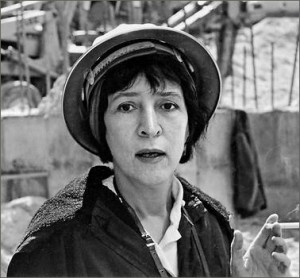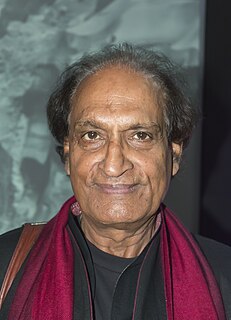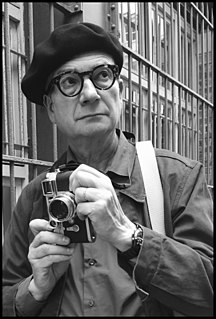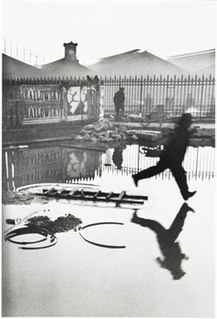Related Research Articles

Henri Cartier-Bresson was a French humanist photographer considered a master of candid photography, and an early user of 35 mm film. He pioneered the genre of street photography, and viewed photography as capturing a decisive moment.
Street photography, also sometimes called candid photography, is photography conducted for art or enquiry that features unmediated chance encounters and random incidents within public places. Although there is a difference between street and candid photography, it is usually subtle with most street photography being candid in nature and some candid photography being classifiable as street photography. Street photography does not necessitate the presence of a street or even the urban environment. Though people usually feature directly, street photography might be absent of people and can be of an object or environment where the image projects a decidedly human character in facsimile or aesthetic.

Helen Levitt was an American photographer. She was particularly noted for street photography around New York City, and has been called "the most celebrated and least known photographer of her time."

Raghunath Rai Chowdhry, known as Raghu Rai, is an Indian photographer and photojournalist. He was a protégé of Henri Cartier-Bresson, who appointed Rai, then a young photojournalist, to Magnum Photos in 1977.

Martine Franck was a British-Belgian documentary and portrait photographer. She was a member of Magnum Photos for over 32 years. Franck was the second wife of Henri Cartier-Bresson and co-founder and president of the Henri Cartier-Bresson Foundation.
Gary Stochl is a street photographer who lives in Stickney, Illinois, just outside Chicago. His work is held in the collections of the Art Institute of Chicago and San Francisco Museum of Modern Art, and published in the book On City Streets: Chicago 1964-2004. Stochl made photographs for 40 years before showing them to anyone.

Cornell Capa was a Hungarian American photographer, member of Magnum Photos, photo curator, and the younger brother of photo-journalist and war photographer Robert Capa. Graduating from Imre Madách Gymnasium in Budapest, he initially intended to study medicine, but instead joined his brother in Paris to pursue photography. Cornell was an ambitious photo enthusiast who founded the International Center of Photography in New York in 1974 with help from Micha Bar-Am after a stint of working for both Life magazine and Magnum Photos.

Bruce Landon Davidson is an American photographer. He has been a member of the Magnum Photos agency since 1958. His photographs, notably those taken in Harlem, New York City, have been widely exhibited and published. He is known for photographing communities usually hostile to outsiders.
Larry Towell is a Canadian photographer, poet, and oral historian. Towell is known for his photographs of sites of political conflict in the Ukraine, Nicaragua, El Salvador, Standing Rock and Afghanistan, among others. In 1988, Towell became the first Canadian member of Magnum Photos.

Saul Leiter was an American photographer and painter whose early work in the 1940s and 1950s was an important contribution to what came to be recognized as the New York school of photography.
Sam Tata was a photographer and photojournalist.

Olivier Meyer is a French photographer born in 1957. He lives and works in Paris, France.
Vanessa Winship HonFRPS is a British photographer who works on long term projects of portrait, landscape, reportage and documentary photography. These personal projects have predominantly been in Eastern Europe but also the USA. Winship's books include Schwarzes Meer (2007), Sweet Nothings (2008) and She Dances on Jackson (2013).

Yau Leung (邱良) (1941–1997) was a well regarded photographer in Hong Kong. Professionally a unit still photographer for Shaw Brothers Studio, he is also known for his photographs of Hong Kong street life. He has been called the "Bresson of Hong Kong", referencing the famous pioneer of street photography, Henri Cartier-Bresson (1908–2004).
Harry Gruyaert is a photographer known for his images of India, Morocco and Egypt as well as of the west of Ireland and for his use of colour. He is a member of Magnum Photos. His work has been published in a number of books, been exhibited widely and won the Kodak Prize.
Humanist Photography, also known as the School of Humanist Photography, manifests the Enlightenment philosophical system in social documentary practice based on a perception of social change. It emerged in the mid-twentieth-century and is associated most strongly with Europe, particularly France, where the upheavals of the two world wars originated, though it was a worldwide movement. It can be distinguished from photojournalism, with which it forms a sub-class of reportage, as it is concerned more broadly with everyday human experience, to witness mannerisms and customs, than with newsworthy events, though practitioners are conscious of conveying particular conditions and social trends, often, but not exclusively, concentrating on the underclasses or those disadvantaged by conflict, economic hardship or prejudice. Humanist photography "affirms the idea of a universal underlying human nature". Jean Claude Gautrand describes humanist photography as:
a lyrical trend, warm, fervent, and responsive to the sufferings of humanity [which] began to assert itself during the 1950s in Europe, particularly in France ... photographers dreamed of a world of mutual succour and compassion, encapsulated ideally in a solicitous vision.
Joshua Mann Pailet is a dealer and collector of fine-art photography, a documentary photographer, and the proprietor of A Gallery for Fine Photography in New Orleans, Louisiana. As a photographer, Pailet documents once-in-a-lifetime events such as the 1976 American Freedom Train, the 1984 World's Fair and the aftermath and devastation of Hurricane Katrina in New Orleans. He opened A Gallery for Fine Photography in 1973, making it one of the first art galleries to be devoted solely to fine-art photography.

Behind the Gare Saint-Lazare is a black and white photograph taken by French photographer Henri Cartier-Bresson in Paris in 1932. The picture has variable dimensions, according to the different prints, being one of them of 44,8 by 29,8 cm. It is one of his best known and more critically acclaimed photographs and became iconic of his style that attempted to capture the decisive moment in photography. The photograph was considered one of the 100 most influential pictures of all time by Time magazine.

Hyères, France is a black and white photograph taken by Henri Cartier-Bresson in 1932. It is one of the photographs from the year when he started taking photography more professionally. He took then many pictures in France and in other countries, like Italy, Spain, Morocco and Mexico, with his portable Leica camera.
References
- 1 2 3 4 Mufson, Beckett (3 January 2017). "The 4 Elements of a Great Candid Photo". Vice . Retrieved 2019-01-28.
- ↑ "Craig Semetko live in Wetzlar // 2014 // Global // Actualités Leica // Univers Leica - Leica Camera AG". fr.leica-camera.com. Retrieved 2019-01-20.
- 1 2 3 "Home". Craig Semetko. Retrieved 2019-01-20.
- 1 2 3 4 5 6 "India Calling: Photographer Craig Semetko's exhibition captures the humour and irony on Indian streets". The Indian Express . 1 June 2017. Retrieved 2019-01-28.
- ↑ Lassiter, Ken (May 15, 2015). "The Charm of Serendipity: A Conversation with Craig Semetko". Photographer’s Forum Magazine. pp. 30–38. Archived from the original on January 21, 2019.
- ↑ Sethi, Shikha (January 2016). "Ways of Seeing: How to be a better photographer (for the instagram generation)". GQ India . pp. 54–55.
- 1 2 3 Paramita Ghosh (4 April 2015). "Looking for grey in Craig Semetko's India Unposed collection". Hindustan Times . Retrieved 2019-01-28.
- ↑ Garfield, Simon (Winter 2014). "Dot Commerce. The Cult of Leica". Esquire, The Big Black Book Issue 4, autumn/winter 2014 UK edition. Retrieved 28 January 2019.[ permanent dead link ]
- ↑ "Inspiration Leica Akademie // 2020 // Global // Leica News // World of Leica - Leica Camera AG". en.leica-camera.com. Retrieved 2020-05-23.
- ↑ Mertens, Heidi; Mertens, Robert (28 March 2020). Inspiration Leica Akademie. ISBN 978-3836269735.
- 1 2 Lisa Morgan, "Craig Semetko: World Renowned Photographer of the Absurd and the Ironic Showing at the AMFM Festival, June 13–16th, in Cathedral City", Coachella Valley Weekly , May 29, 2013. Retrieved 2019-01-28.
- 1 2 "Craig Semetko: Capturing the Authentic Human Experience, Part 1", Leica Blog, October 29, 2010. Retrieved January 2019-01-29.
- ↑ "Craig Semetko: America: E Pluribus Unum", Leica Blog, October 17, 2012. Retrieved 2019-01-29.
- ↑ Holteen, Ted (23 May 2013). "More than words can say". The Durango Herald . Retrieved 2019-01-28.
- ↑ "Craig Semetko". Leica Gallery Los Angeles. Retrieved 2019-01-29.
- ↑ "Craig Semetko – India Unposed & Torsten Andreas Hoffmann – India on the move", Leica Galerie Frankfurt. Retrieved 2019-01-28.
- ↑ "Gallery Opening and Book Signing Session with Craig Semetko", Leica Store Singapore, as archived by the Wayback Machine on March 29, 2015.
- ↑ "Craig Semetko". Vadehra Art Gallery. Retrieved 2019-01-28.
- ↑ "Craig Semetko – Funny Business", Leica Store Nürnberg. Retrieved 2019-01-28.
- ↑ "Exhibitions". Street Photo Milano. Retrieved 2019-01-29.
- ↑ "Craig Semetko | For Your Amusement // News & Program // Leica Gallery Melbourne // Leica Galleries - Leica Camera AG". us.leica-camera.com. Retrieved 2020-05-23.
- ↑ "Leica Artist Talk & Exhibition with Craig Semetko – Visual Voyager". visualvoyager.net. Retrieved 2020-05-23.
- ↑ "Craig Semetko: Inside India Unposed", Leica Blog, August 22, 2014. Retrieved 2019-01-29.
- ↑ "Leica Gallery Wetzlar Inaugural 10 x 10 Exhibition", Leica Blog, June 26, 2014. Retrieved 2019-01-29.
- ↑ "10×10", Leica Fotografie International, June 24, 2014. Retrieved 2019-01-29.